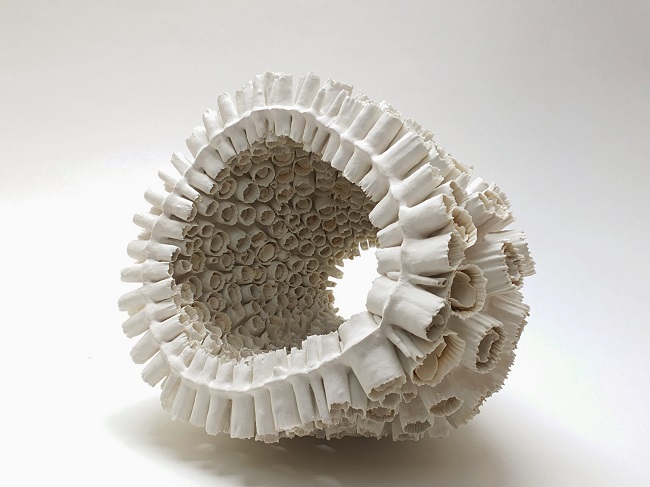Two person shows can be problematic. The chemistry between the artists may not always be complimentary. But the pair that Puls Contemporary Ceramics in Brussels is currently exhibiting, Thérèse Lebrun and Yoshimi Futamura (on exhibit until June 7) is like a classical violin duet, both play a similar melody but with shifting pitches and tonality. It is an exercise that is perfectly sonorous, the one informs the other.
Lebrun’s work recalls things you may have collected on the beach as a child with the look of found natural objects, defying you to think that they were man-made. She molds porcelain around an organic material that burns away during the firing process, leaving hundreds of thin, semitransparent voids clustered around an empty space.
The gallery states:
“Since 2004, she has focused on mastering the potentials of paper-thin porcelain. Lebrun creates shapes, objects that are utterly empty. These are reminiscent of remnants of former living things and—dare we say it—living beings, that evolution must have forgotten to finish. Hers is the forgotten world of the past; fossils, petrified plants, and the leftover plant structures with traces of ancient rhythms, order and disorder. She continues her research using the vestiges of a past world or forms that exist only in her imagination. This is evolution that Darwin never dreamed of. Lebrun gives us fragility, translucence, and boundaries in porcelain that touches all manner of once living surfaces. She creates hiding places for imaginary new life forms yet to evolve.”
Lebrun is a part-time lecturer at the Ecole des Arts d’Ixelles in Belgium.
While Lebrun’s sculptures are paper-thin, delicate and elegantly drawn from the coral reef, Futamura’s work has a more rugged look, lava-like. Her’s appear to have been transformed rapidly in fire and heat. But in fact the process is very careful and considered.
Yoshimi Futamura has lived and worked out of her studio in Paris since 1986, except for when she is an artist in residence in China and in her native Japan. Futamura gives the works the appearance of lava rocks or charred firewood and says that she wants her pieces to express movement and the fundamental power within clay., “The earth is the raw material of my work. I strive to express its energy and natural strength. Earth plus water plus Fire. It is thanks to these three elements that I can give birth to a new life.”
Garth Clark is the Chief Editor of CFile.
Above image: Ceramic sculpture by Thérèse Lebrun. Photograph courtesy of the gallery.
Any thoughts about this post? Share yours in the comment box below.

Works by Thérèse Lebrun.

Works by Thérèse Lebrun.

Works by Thérèse Lebrun.

Thérèse Lebrun

Works by Yoshimi Futamura.

Works by Yoshimi Futamura.

Works by Yoshimi Futamura.

Works by Yoshimi Futamura.

Works by Yoshimi Futamura.

Works by Yoshimi Futamura.

Works by Yoshimi Futamura.

Works by Yoshimi Futamura.

Yoshimi Futamura. All photographs courtesy of the gallery.

These pieces look like they were made by nature. Beautiful.
Stunningly fascinating pieces of work. I just want to keep staring.